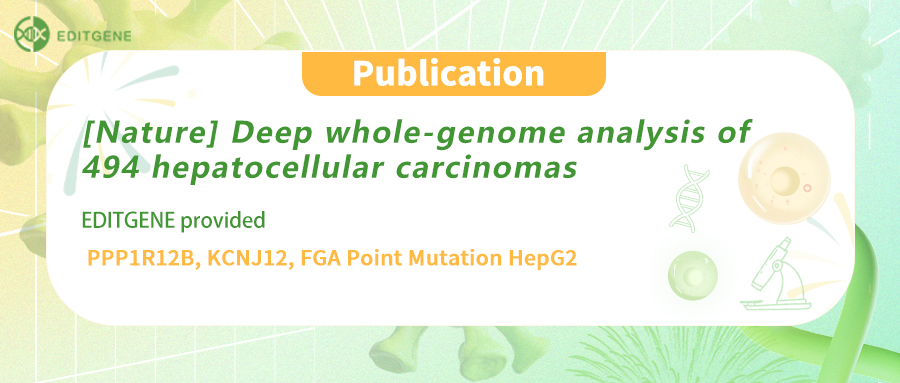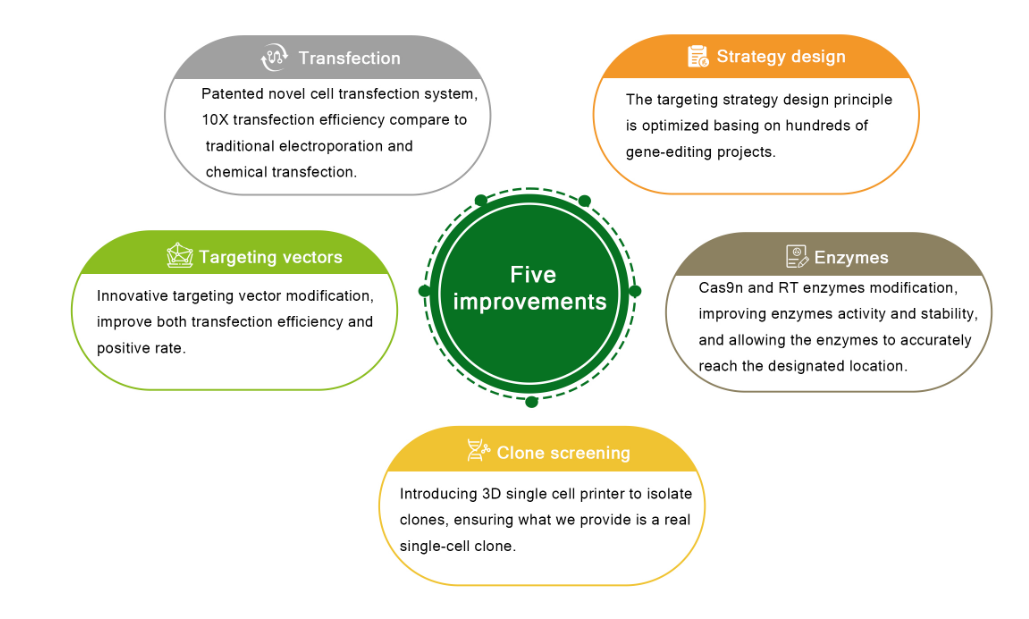[Nature] CRISPR Point Mutation Cells Help Deep Whole-genome Analysis
Bingo™ Prime Editing Platform

The study titled "Deep whole-genome analysis of 494 hepatocellular carcinomas" published in Nature used PPP1R12B, KCNJ12, and FGA point mutation H ep G 2 cells , which were constructed by EDITGENE , to validate potential driver events .
China is a major country for liver cancer, accounting for a considerable proportion of new cases and deaths worldwide each year. The incidence of hepatocellular carcinoma (HCC) continues to rise in China, which is mainly related to the high prevalence of hepatitis B virus (HBV) infection. According to statistics, about 80% of liver cancer patients in China can be attributed to HBV infection. Despite the availability of multiple treatment options, the prognosis of HCC remains poor, in addition, the lack of early diagnosis rate limits the therapeutic efficacy. Although the development and application of techniques such as liver spiral CT multiphase enhancement scanning have improved the diagnosis rate of hepatocellular carcinoma, some imaging features of hepatocellular carcinoma are still difficult to accurately determine due to the heterogeneity of tumorigenesis and development.
In this study, 494 tumor tissues of hepatocellular carcinoma patients from different regions of China were subjected to high-depth whole-genome sequencing, and features such as driver genes in coding and non-coding regions, mutation imprinting, copy number variation, clustered mutation events, extrachromosomal loops, and mutation evolution patterns were analyzed in depth, which revealed a genome-wide mutation landscape with a predominant focus on HBV-associated hepatocellular carcinomas, and provided important clues for the in-depth understanding of hepatocellular carcinoma evolution mechanisms in Chinese populations.
It was found that the CLCA-HCC cohort exhibited a higher prevalence of HBV infection, higher Edmondson-Steiner grade III-IV staging, and lower prevalence of HCV infection, smoking history, and percentage of drinking history compared with the PCAWG-HCC cohort. These marked differences in epidemiologic and clinicopathologic characteristics reflect the uniqueness of the CLCA-HCC cohort and provide important background information for subsequent in-depth analyses.
At the gene level, the team identified a large number of novel potential driver events for liver cancer, including both coding and non-coding driver events. Surprisingly, only a few of these newly identified events have been reported by previous studies, which highlights the limitations of current studies on non-coding regions of liver cancer. Further analysis showed that these non-coding driver events do not occur only in the early stages of hepatocellular carcinoma, but are extensively involved in the subclonal evolution of hepatocellular carcinoma.
In addition, the research team identified for the first time five new mutational imprints that have unique characteristics and potential pathogenic factors compared to known mutational imprints. Among them, ID_H8 was associated with aflatoxin exposure, while DBS_H2 and ID_H3 were associated with aristolochic acid exposure. The discovery of these new mutational imprints not only enriches our understanding of the mutational mechanisms of hepatocellular carcinoma, but also provides new perspectives for future prevention and intervention.
In terms of genomic variant events, the team depicted in detail the different types of genomic variant events in the CLCA cohort, including copy number variants, structural variants, HBV integration, ecDNA and three types of aggregated variant events. Among them, the high percentage of ecDNA and the unique oncogene profile attracted the attention of the researchers. They found that HBV can form ecDNA with the host genome and increase the copy number and expression level of neighboring driver genes through this form of integration. This finding provides a new explanation for the pathogenesis of HBV-associated hepatocellular carcinoma.
Finally, the investigators verified the newly identified potential driver events PPP1R12B, KCNJ12, FGA mutations by Prime Editing point mutation cell lines ( Generated by EDITGENE ) . The results of these experiments demonstrated that mutations in these potential driver events could indeed affect the gene expression level and the malignant phenotype of hepatocellular carcinoma cells. Among them, the potential driver gene FGA affected the malignant phenotypes of multiple hepatocellular carcinoma cells by negatively regulating the TYK2-STAT3-IL6 signaling pathway, a finding that provides a new potential target for hepatocellular carcinoma treatment.
EDITGENE 's Bingo™ Prime Editing Platform provide s efficient gene KI cell line customization service. C ontact us to get a quote>>

Recent Posts
[FEB Bestselling] CRISPR Screen for Metabolic, Transcription Factor, RNA-Binding Protein
[Research Frontier] New trends in CRISPR-- KO Cells Reveal Key Factors in Ferroptosis
CRISPR screen decodes stimulatory responses of primary T cells
Contact Us







![[Nature] CRISPR Point Mutation Cells Help Deep Whole-genome Analysis](/uploads/20241026/xGoUXOjQ6eKwHJ5C_6b1e7d3bcc99e579649fc9f8f24ceae0.jpg)

Comment (4)